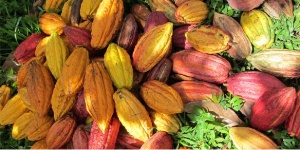- Home - News
- TWI News | TV
- Polls
- Year In Review
- News Archive
- Crime & Punishment
- Politics
- Regional
- Editorial
- Health
- Ghanaians Abroad
- Tabloid
- Africa
- Religion
- Election 2020
- Coronavirus
- News Videos | TV
- Photo Archives
- News Headlines
- Press Release
Business News of Tuesday, 8 September 2015
Source: B&FT
CRIG wants partners to market by-products
The Cocoa Research Institute of Ghana (CRIG) of the Ghana Cocoa Board is asking entrepreneurs for partnerships to produce and market its cocoa by-products on the international consuming market.
This will help farmers generate extra income through the processing of their produce and by-products.
Currently, the Institute is in close collaboration with the Ghana Investment Promotion Centre to help promote the cocoa by-materials and products.
The CRIG has over the years spearheaded development and production of by-products -- such as body creams, bathing soap and other liquid soap products, jam for bread, and some bitters and wine -- from its cocoa products.
“Over the years we have put a lot of effort into promoting these materials, and we have been asking Ghanaian entrepreneurs to partner in producing them on large scale for both the local and international markets.
“We have been doing this for the past decade: however, the investors are not forthcoming so we hope that with further publicity they will come along and produce this at large scale, so that they will be abundant in the market,” Executive Director of the Cocoa Research Institute, Dr. Gilbert Anim Kwapong told B&FT during an interview at Tafo in the Eastern Region, where the Institute hosted delegates from the United States to acquit themselves with the county’s cocoa value chain issues.
Dr. Kwapong explained that the Institute conducts research and development into production of animal feed from cocoa-pod husks; toilet soap and cosmetics from cocoa butter extracted from discarded beans; alcoholic beverages and industrial alcohol, soft drinks, marmalade and jelly, pectin, theobromine and acetic acid from cocoa sweatings.
It has also conducts research and development into production of toilet soap and cosmetics from shea butter and alcoholic beverages, and jam from cashew. It assesses the economic and commercial viability of large scale production of such products.
In the processing of cocoa beans for the market, the pod husk, bean pulp juice and the placenta, which constitute 66, 4 and 10% respectively of the fruit, are traditionally discarded as waste.
Research carried out at CRIG from 1970 to 1983 demonstrated that these wastes can be processed into commercially useful products.
Interest in development and utilisation of cocoa by-products from fresh pods and farm waste dates back to the Institute’s inception, he said.
The institute has so far produced cocoa pod husks which have been processed into animal feed by processes of slicing, partial drying, and pelletising into granules. The dried pellets are used in animal feed formulations.
Feeding trials have been conducted on sheep, pigs and poultry by CRIG in conjunction with the Animal Research Institute (ARI), Accra and University of Science And Technology KNUST, Kumasi.
The Institute, he said, has again developed potash -- a product from burnt dry cocoa pod husks that is the main source of alkali used by the local soap industry for production of Local Soft Soap, also called ‘Alata Samina’. “Liquid soap has been developed at CRIG from potash produced from burnt cocoa pod husks.”
Potash, produced in addition to cocoa butter, is used to formulate dark soap. This soap derived its name from its colour, and not only has moisturising effects on the skin but also has curative powers against all manner of skin rashes.











